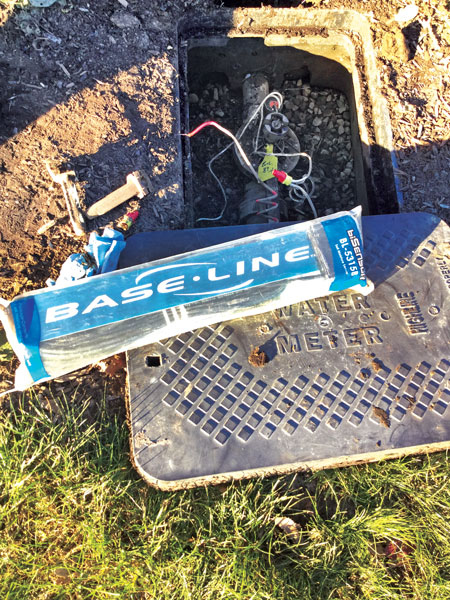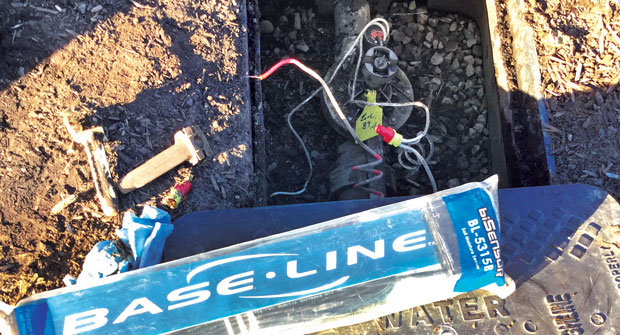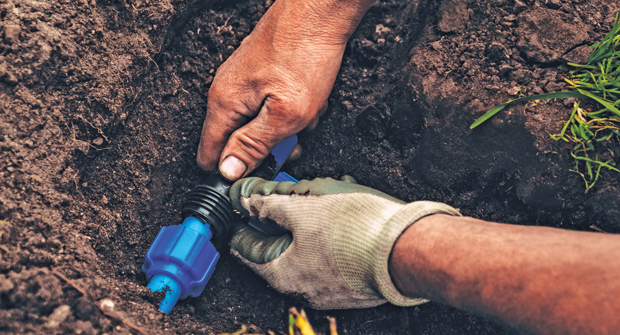
Pacific Landscape Management has been using soil-moisture sensors on its commercial properties to help conserve both water and clients’ money. Pictured is the Baseline biSensor the company commonly uses. (Photo: Pacific Landscape Management)
Pacific Landscape Management in Hillsboro, Ore., has been using smart irrigation products for many years. One such product is soil-moisture sensors.
“We’ve learned that you need to have enough of them in different locations so your readings aren’t just based on a sunny or shady location, an area with tree roots or certain types of soil,” says Bob Grover, president. “The locations you place them in must provide readings that are indicative of the entire site.”
David Thurman, irrigation manager for Texas Landscape Group in Houston, is also a proponent of soil-moisture sensors. “They know the difference between a half-inch and 5 inches of rain, so they are more accurate than a rain sensor,” he says. “You just need to make sure you’re strategically placing them around a property.”
Some cost-conscious clients may balk at the use of soil-moisture sensors. That is why Thurman’s more widely used tool is a rain sensor. He says they are easy to install and use. He especially likes the wireless versions.
Thurman and Grover also have become proponents of irrigation smart-control software. “The whole theory is that once a system is calibrated, it starts making adjustments on its own,” Grover says. “That eliminates guesswork.”
Since he tends to rely more on rain sensors, Thurman has come to appreciate having the ability to make manual scheduling adjustments.
“Sometimes things get so saturated after several days of rain that we simply don’t need to irrigate for a few days,” Thurman says. “I can make controller adjustments on any of our sites, right from my desk.”
Four experts from leading irrigation suppliers offer some additional advice on how to leverage sensors and software to save water, time and money.
Hunter Industries

Darik Chandler
Associate product manager
Sensors are powerful tools that help ensure healthy, cost-effective and water-conscious landscapes. When paired with advanced water management software, they provide useful information such as how much water is applied to plant material and the need for maintenance. Hydrawise software allows landscaping professionals to remotely monitor an unlimited number of sites and understand critical issues before costly landscape damage occurs. Along with Hydrawise, professionals should use a flow-monitoring device such as the HC Flow Meter for automatic shut-off triggers by zone if unusual water use is detected, a controller with built-in milliamp sensing to monitor solenoid load and a rain sensor for reliable shut-off if precipitation occurs — a requirement that is increasingly mandated by water agencies nationwide.
Jain Irrigation

Richard Restuccia
Vice president, water management solutions
While weather-based and soil-moisture-based sensors both help save water, weather-based sensors work better in most landscape situations. Weather-based sensors use local weather data to determine accurate evapotranspiration for a property. The data is analyzed by software, and the best software creates and adjusts irrigation schedules based on the data. Soil-moisture sensors, on the other hand, measure the amount of water in the soil. This information is communicated to software, and irrigation schedules are created. This type of sensor works great for agriculture where 1 acre looks just like the next 100 acres. In landscape applications where you have shady parts of a landscape plus a wide variety of plants, soil-moisture sensors are not practical.
Irritol

Matt Hall
Product marketing manager
Sensing products combine predictive technology with real-time information to help fine-tune watering schedules faster than running calculations by hand. They also help eliminate a lot of guesswork. When combined with the latest software tools, contractors can respond to situations in the field faster using their mobile device or PC, saving time and money. When weighing sensor options, contractors should consider solutions that work for both existing and new system installs. For many systems, upgrading to weather sensing and software options could require the purchase of a new controller, which could get costly. Selecting sensors that can be easily added to expand the capabilities of a new or existing controller helps to manage costs and cut down on the learning curve.
Rain Bird

Rick Malkin
Product manager — central control products
Affordable weather stations and rain, temperature, wind and flow sensors make it possible to vastly improve irrigation efficiency. Accompanying software makes sensor monitoring and control easily accessible via Wi-Fi and cellular connections. At sites with flow sensors, a controller carries out preprogrammed actions to diagnose the high- or low-flow condition and can shut down the problem water source. This limits liability and costs associated with broken pipes, stuck valves, water loss and unauthorized water use. When selecting flow sensors and software, it’s important to consider the administrative and water management features you’ll need on the back end.


